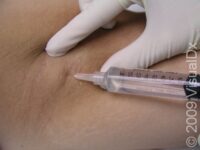
Common Dermatologic Procedures
Many common dermatologic procedures are done as office procedures to test for a wide variety of diseases or to treat often minor dermatologic diseases or conditions in a quick and noninvasive manner.
Some common dermatologic techniques used to test for diseases are biopsies, including punch, shave, and excision biopsy; microbiological culture (often called a skin culture); skin allergy patch testing, and Wood’s lamp examination. The results from these tests can be used to either confirm or rule out a diagnosis, such as skin cancer or a fungal skin infection. Mohs surgery is a relatively new dermatologic procedure that is used to both test and treat cancerous skin.
Other dermatologic procedures are used to remove or treat benign or cancerous skin lesions. Cryotherapy, curettage, cyst excision, electrodesiccation, phototherapy, and skin tag removal are examples of the types of methods physicians use to destruct, remove, or treat skin for a wide variety of diseases and conditions.
There are also procedures, such as general local anesthesia and suturing, that are routinely used in conjunction with other common dermatological procedures like skin biopsy, curettage, cyst excision, and so forth.
The content in the topics below includes an overview of each procedure; a description of why the procedure is likely necessary; what happens before and during a procedure; what to expect after a procedure, including post-procedure care; what risks / side effects each procedure carries; and what potential alternatives there are to each procedure.
Click an individual dermatologic procedure for relevant clinical images and content.
Best Matches
